Physical Address
304 North Cardinal St.
Dorchester Center, MA 02124
Chest radiography (CXR) and chest tomography (CT) have been the mainstays of thoracic imaging for decades, and 18-fluorodeoxyglucose positron emission tomography (FDG-PET)–CT has more recently proven its value in staging lung cancer and metastatic disease within the thorax. Upon technical improvements that have addressed challenges related to cardiorespiratory motion, magnetic resonance imaging (MRI) has become appreciated for its capability in tissue diagnosis, without ionizing radiation exposure. The term thoracic MRI is defined here to encompass all of thoracic MRI except cardiovascular and breast MRI.
Magnetic resonance imaging has proven impactful as a problem solver in the thorax when lesions are indeterminate by CT. Although problem solving with MRI has been largely focused on the mediastinum and pleura, its applications in the lung have been increasing, with examples including serial follow-up of patients with cystic fibrosis, tissue characterization of indeterminate but probably benign pulmonary nodules on CT greater than or equal to 1 cm, and discernment of tumor from postobstructive atelectasis.
In addition to full chest MRI for mesothelioma, there has been increased use of MR to screen for and follow various disease entities in the thorax without ionizing radiation exposure, such as endometriosis, chronic lymphocytic leukemia and lymphoma in young and pregnant patients ( Fig. 3.1 ), cystic fibrosis, paragangliomas (e.g., SDHD mutation), teratomas (NMDA [ N -methyl- d -aspartate] receptor antibodies), carcinoid tumors (multiple endocrine neoplasia type 1), and syndromes with high risk for malignancy (e.g., Li-Fraumeni syndrome).
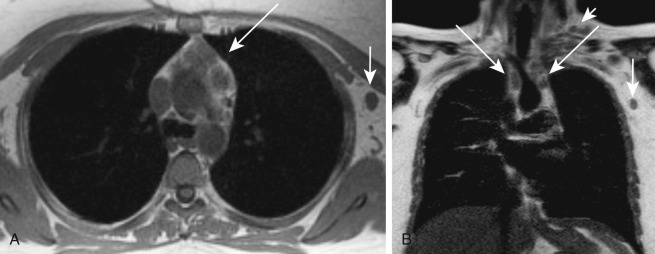
The ability to make a diagnosis and impact clinical management without ionizing radiation exposure is a substantial benefit of MR over CT, provided MR is used for appropriate indications (see Fig. 3.1 ).
The high soft tissue contrast of MRI and chemical composition analysis by this modality offer a multitude of diagnostic benefits, including:
Better definition of soft tissue planes
More accurate determination of the compartment where a lesion resides ( Fig. 3.2 )
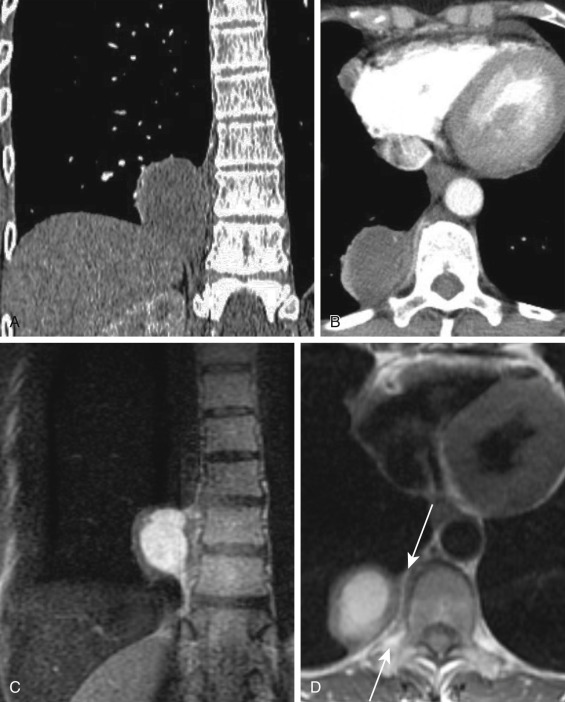
Better demonstration of neurovascular, esophageal ( Fig. 3.3 ), and chest wall involvement
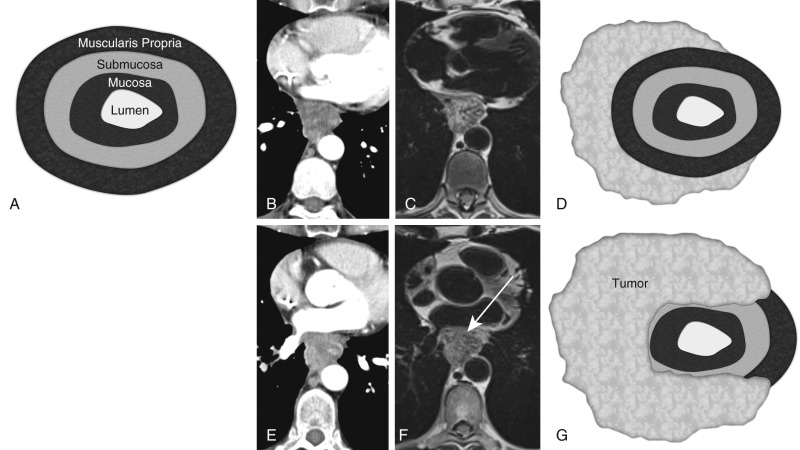
Definitive differentiation of cystic from solid lesions (hyperattenuating hemorrhagic and proteinaceous cystic lesions can be misperceived as solid on CT) ( Fig. 3.4 )
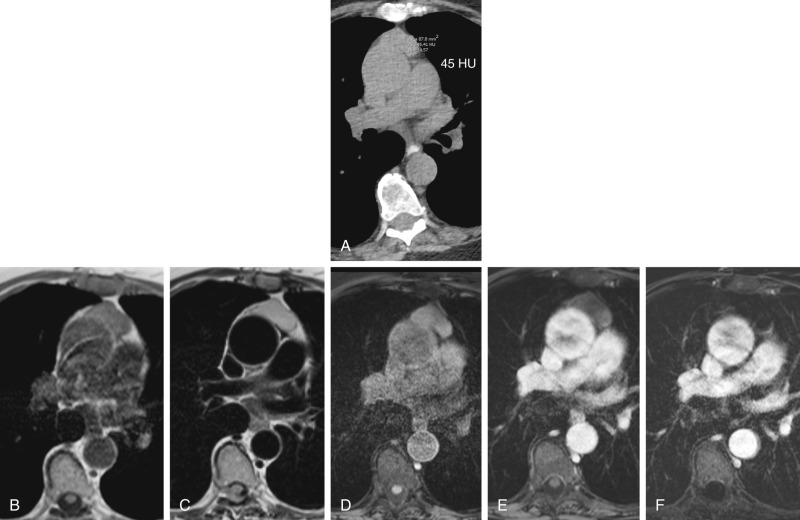
More thorough and sensitive depiction of lesion complexity (heterogeneous composition, small nodules, septations, wall asymmetries, and irregularities)
Detection of microscopic fat (in addition to macroscopic fat), blood products, fibrous tissue, cartilage, and smooth muscle
Differentiation of muscles from nerves, tendons, and ligaments
These strengths of MR regarding tissue characterization and compartmental localization often yield higher diagnostic specificity, more accurate assessment of resectability, guidance to the interventionist regarding optimum (solid, cellular) sites for biopsy for higher diagnostic yield ( Fig. 3.5 ), guidance to the thoracic surgeon regarding the surgical approach, prevention of unnecessary diagnostic intervention, and prevention of unnecessary follow-up imaging and related clinical care.
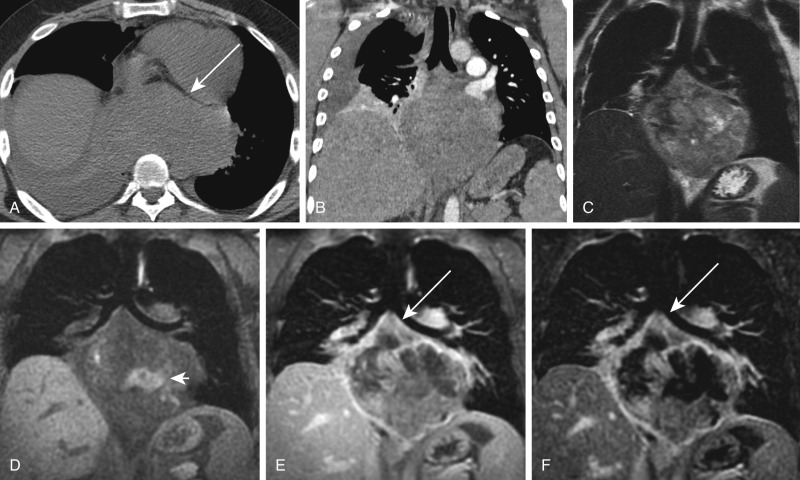
Used judiciously, MR therefore offers great value, defined by Harvard Business School professor Michael E. Porter as quality divided by cost. Professor Porter puts it simply: “To reduce cost, the best approach is often to spend more on some services to reduce the need for others.” He stresses thinking about the full cost over the care cycle of the patient, rather than the cost of an individual test. When MRI makes a more precise tissue diagnosis than CT, better defines tissue planes and invasiveness for the surgeon, prevents unnecessary surgery and its associated morbidity and mortality, and prevents unnecessary follow-up imaging, then it has saved a substantial amount over the care cycle of the patient and is invaluable.
The basic principles of MR tissue characterization in other parts of the body are fully applicable to lesions in the thorax. Generally, the signal intensity of a lesion is described in reference to skeletal muscle on the same image and referred to as hypointense, isointense, or hyperintense (to muscle). If another reference standard is used besides muscle, it is helpful, when reporting the study, to specify the tissue to which the signal of the lesion is being compared. Table 3.1 lists the typical MR signal characteristics of various lesion tissue types encountered in the thorax (and elsewhere). Knowledge of the classic signal characteristics of these tissue types can markedly narrow the differential diagnosis of a lesion.
| Tissue Type | T1 Signal Intensity | T2 Signal Intensity | Enhancement Pattern | Restricted Diffusion |
|---|---|---|---|---|
| Serous cyst | Hypointense | Hyperintense | No internal enhancement; may see thin, smooth wall enhancement | No |
| Proteinaceous or hemorrhagic cyst | Isointense or hyperintense | Hyperintense | No internal enhancement; may see thin, smooth wall enhancement | No, unless old congealed blood or hematoma, which can be restricted |
| Microscopic fat | Not discernible on in-phase images; hypointense on opposed-phase images | NA | NA | NA |
| Macroscopic fat | Hyperintense | Hyperintense | No enhancement | No |
| Cartilage | Hypointense | Hyperintense | Little to no enhancement of cartilage substance; enhancement of scaffolding or rim or septations, however | No |
| Fibrous tissue | Isointense | Iso- to hypointense (T2-hypointense compared with most lesions) | Gradual, sometimes limited | DWI hypo intense (collagen, no water), ADC hypointense |
| Smooth muscle | Isointense | Isointense (T2-hypointense, compared with most lesions) | Gradual | Variable |
* Signal intensity is described relative to skeletal muscle . Skeletal muscle is intermediate in signal on T1-weighted images and of low signal on T2-weighted images.
Cysts and fluid collections are almost always very T2-hyperintense (to muscle) or -isointense to cerebrospinal fluid (CSF) ( Fig. 3.6 ), with the exception of endometriomas and other long-standing hemorrhagic cysts, which may be T2-hypointense, exhibiting “T2-shading” secondary to their highly concentrated iron content ( Fig. 3.7 ). Because cysts contain fluid, they do not internally enhance, with the exception of lymphangiomatous locules into which intravenous (IV) contrast may eventually seep with time. The walls of benign cysts lined by epithelium may exhibit thin, smooth wall enhancement. Unilocular cysts with no wall enhancement or thin smooth wall enhancement are virtually always benign. Inflammatory cyst walls typically enhance. Irregular, nodular, or asymmetric wall enhancement of a cystic lesion or enhancing septations warrant consideration of a more complex benign multilocular lesion (e.g., a multilocular lymphangioma (see Fig. 7.11 ) or multilocular thymic cyst), an inflammatory lesion, and a cystic neoplasm. The T1 signal of cysts is variable, depending on the nature of the fluid. If the fluid is serous, the T1 signal will be hypointense. Hemorrhagic or proteinaceous fluid and fatty fluid are generally T1-isointense or -hyperintense to muscle. Cysts occasionally exhibit fluid–fluid levels that have been referred to as “hematocrit levels,” in the context of hemorrhagic cysts (see Fig. 5.10 ).
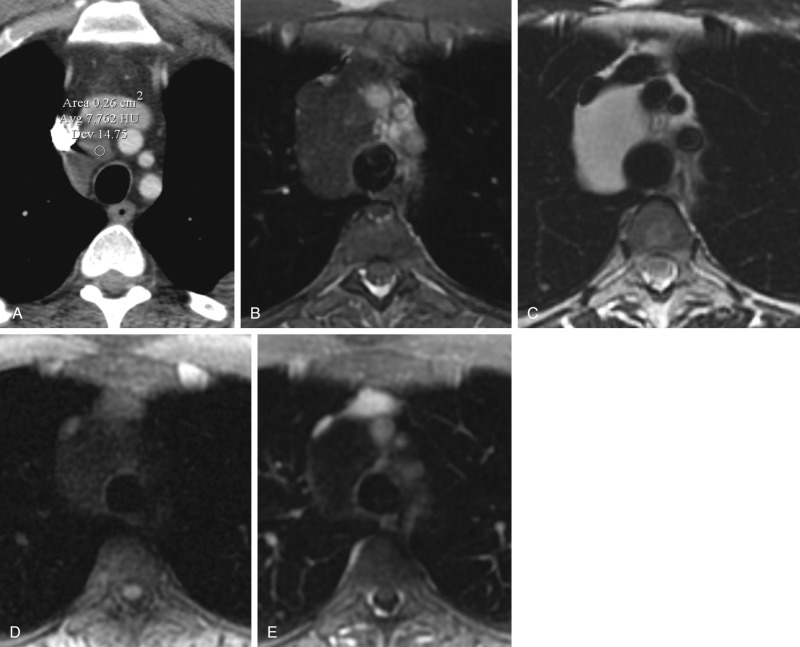
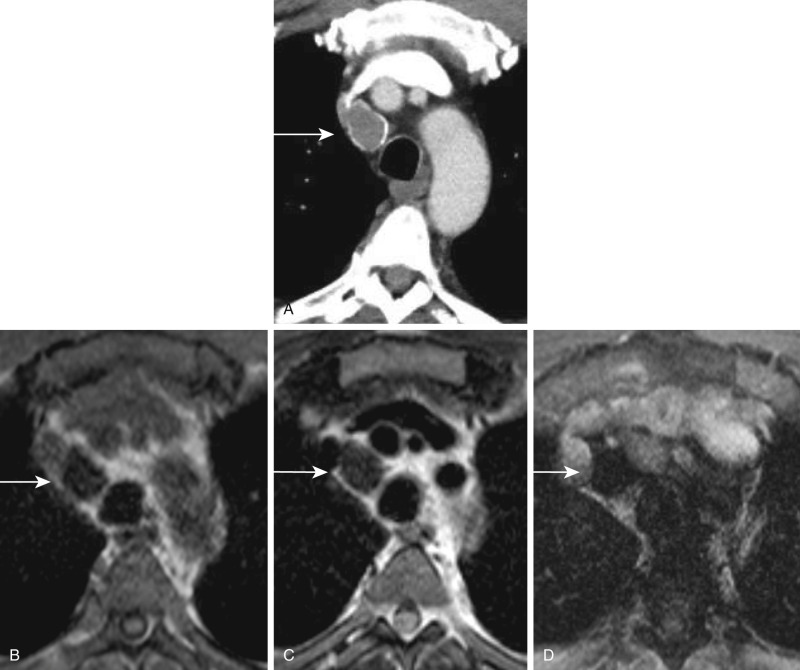
Magnetic resonance imaging has higher sensitivity and specificity than CT for the detection of and distinction between blood products. For this reason, it is the test of choice when screening for endometriomas ( Fig. 3.8 ). The signal characteristics of hemorrhage and hematomas vary over time and depend on the age and volume of blood. The most useful signal characteristics of blood products to remember are:
Methemoglobin is T1-hyperintense, whether intracellular or extracellular, T2-hypointense if intracellular, and T2-hyperintense if extracellular.
Chronic recurrent hemorrhage within a cyst may yield iron accumulation, with resultant T2-hypointensity or “T2 shading,”
Hemosiderin is invariably T1- and T2-hypointense.
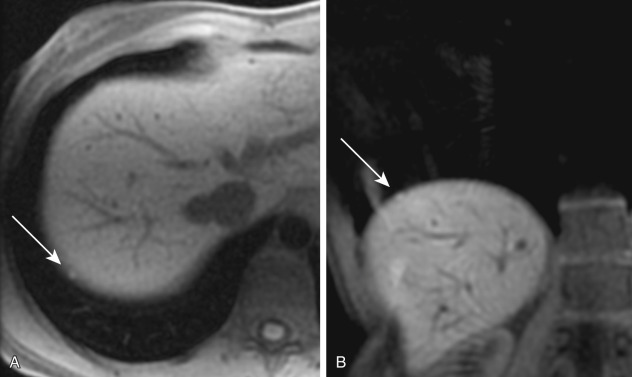
Magnetic resonance imaging cannot readily identify calcification, unlike CT. Nevertheless, when foci or a rim of T2-hypointensity is observed in a lesion in which calcification can occur, the presence of calcification can be suggested.
Become a Clinical Tree membership for Full access and enjoy Unlimited articles
If you are a member. Log in here